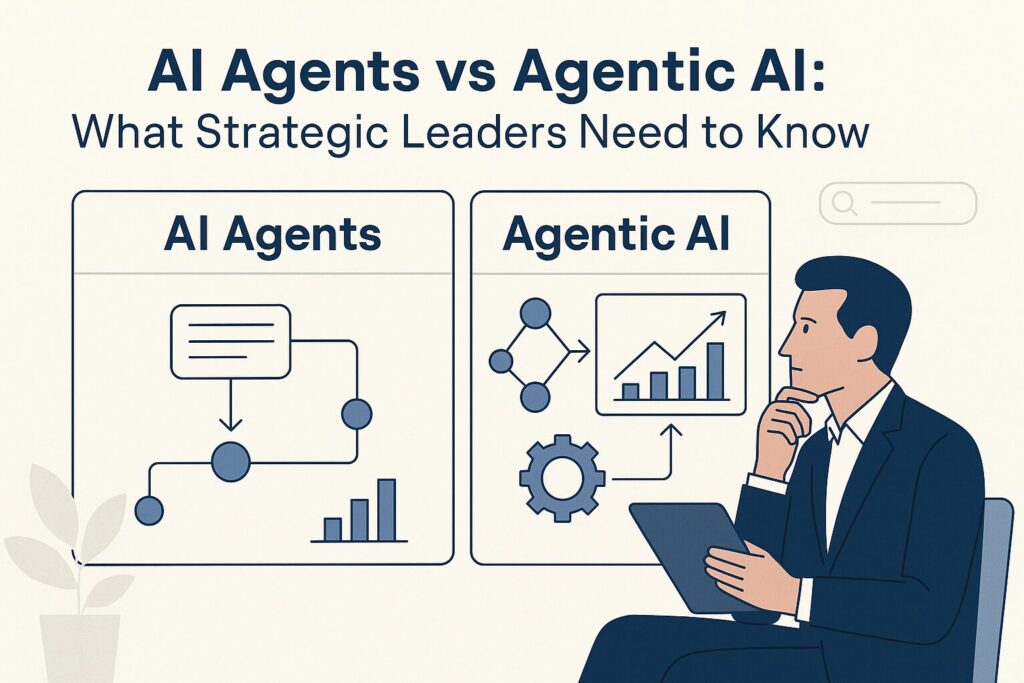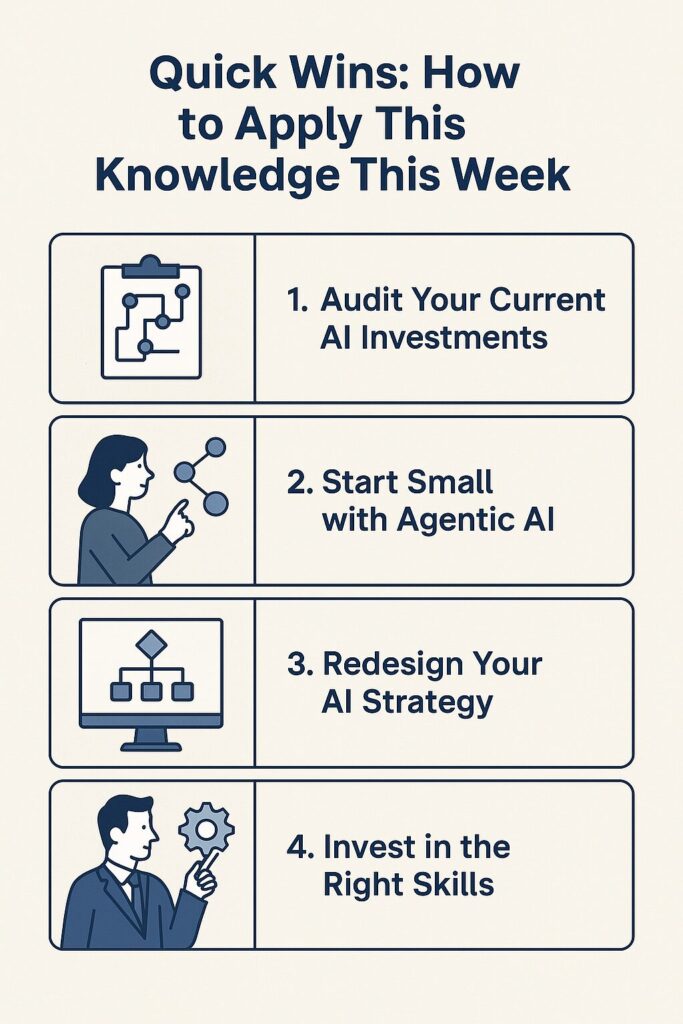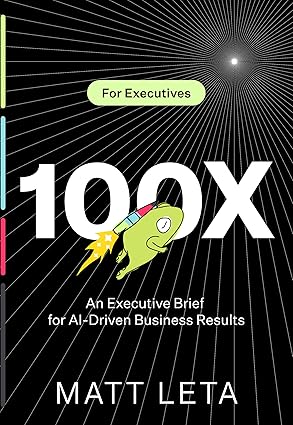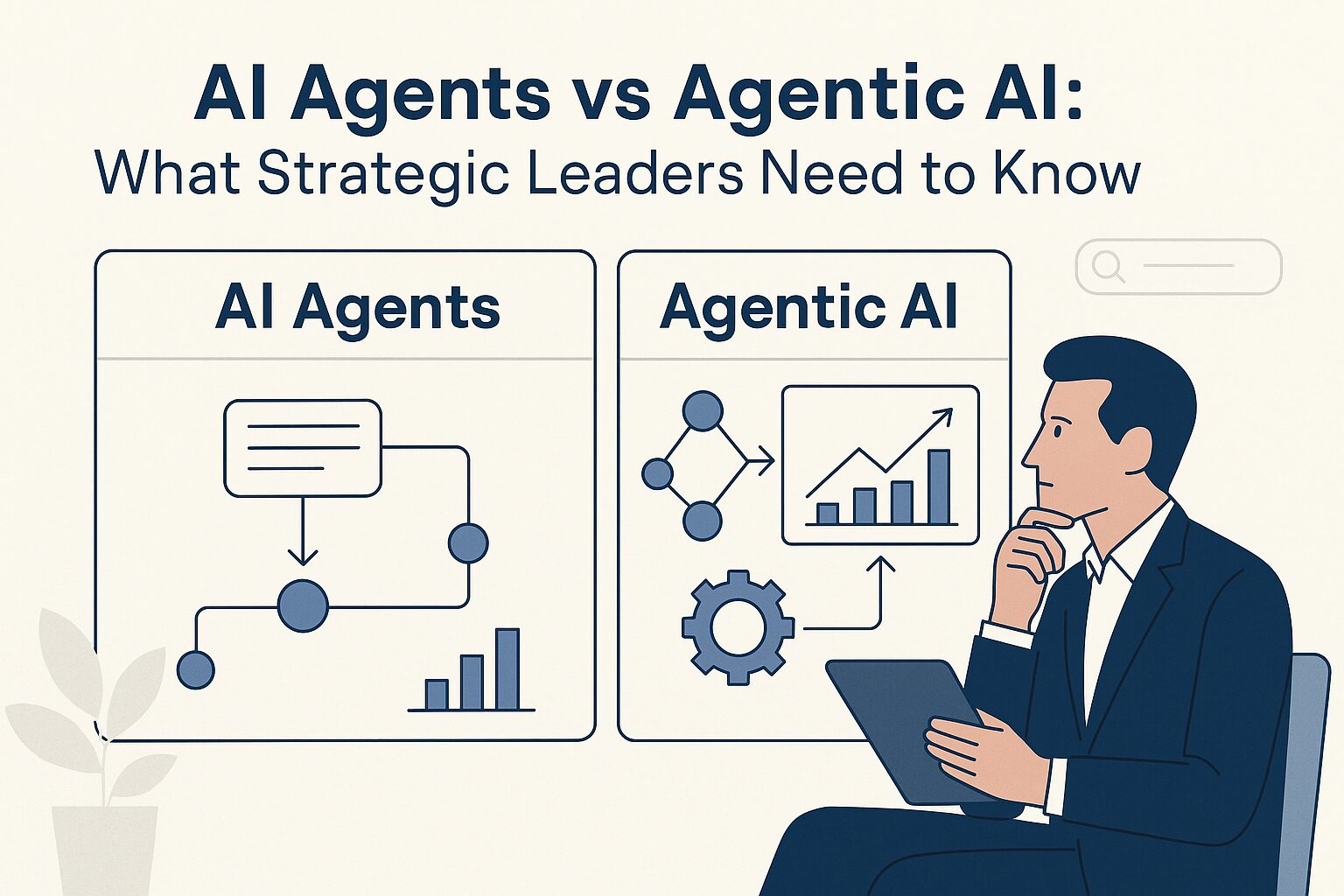Your competitor cut operational costs by 35% while you’re still debating whether ChatGPT counts as an “AI strategy.”
Here’s what happened: While you implemented basic AI agents to handle customer service tickets, they deployed agentic AI quietly, rewriting their entire business playbook. Their system doesn’t just answer questions, it identifies which customers are about to churn, adjusts pricing in real time, and even spots market opportunities your team hasn’t thought of yet.
The kicker? They’re using the same budget you allocated for “AI initiatives” last quarter.
I see this gap widening every single day. Companies are throwing money at AI solutions without understanding the fundamental difference between tools that follow orders and systems that can think strategically.
It’s like bringing a calculator to a chess match and wondering why you keep losing.
The brutal truth is that while you’re optimizing email responses with AI agents, your most innovative competitors are unleashing agentic AI systems that are essentially running parallel businesses, identifying opportunities, making strategic decisions, and executing complex operations without human intervention.
And if you don’t understand the difference between these two approaches, you’re about to get left behind in a way that’ll make the digital transformation scramble of 2020 look like a gentle warm-up.

What Most Leaders Get Wrong About AI Agents
Let me tell you about a conversation with a VP of Operations at a mid-sized logistics company. She was frustrated because her team had invested in what they called “AI agents” to handle customer service inquiries. Six months later, they were still manually reviewing every response, and customer satisfaction hadn’t budged.
The problem? They were thinking about AI agents like human employees who could figure things out. That’s not how this works.
AI agents are task-specific tools. Think of them as really smart calculators that can handle complex workflows. These agents execute predetermined actions within defined parameters. Your customer service agent can pull up order histories, check inventory levels, and even process returns, but only if you have explicitly programmed those capabilities.
According to BCG’s 2024 “AI Adoption in 2024” survey, approximately 74% of companies struggle to scale AI initiatives and achieve tangible value, and the majority of these challenges stem from people‑ and process‑related issues, rather than technical shortcomings.
The mindset shift here is crucial. AI agents are powerful execution engines, not strategic thinkers. They excel at “if this, then that” scenarios but struggle with ambiguity and novel situations.
The Agentic AI Advantage: When Machines Think
Now, agentic AI? That’s a different beast entirely.
Agentic AI systems can set goals, make decisions, and adapt strategies based on changing conditions. They don’t just follow scripts. They write their scripts based on what they’re trying to achieve. This strategic advantage can empower you to make bold decisions and stay ahead of the competition.
Here’s my go-to teaching framework for understanding the difference:
The GOAL Framework for Agentic AI
G – Goal-Setting Capability: Agentic AI can define its objectives within broader parameters. If you tell a traditional AI agent to “improve customer satisfaction,” it needs step-by-step instructions. Agentic AI can break that down into sub-goals: reduce response times, personalize interactions, and proactively identify at-risk customers.
O – Operational Autonomy: These systems can choose their methods and tools. Instead of following a fixed decision tree, they evaluate options and pick the best approach for each situation.
A – Adaptive Learning: Agentic AI doesn’t just learn from training data—it learns from every interaction and adjusts its behavior accordingly. It’s like having a team member who gets better at their job daily.
L – Long-term Reasoning: This is the big one. Agentic AI can think several steps ahead, considering how today’s actions impact tomorrow’s outcomes.
According to a 2025 overview on agentic AI, systems endowed with memory, communication, and planning outperformed coordinated human teams in 64% of scenarios, demonstrating their ability to optimize outcomes beyond typical task execution.
Real-World Examples: Where the Rubber Meets the Road
Let’s examine how this difference between traditional and agentic AI plays out in real operations.
Traditional AI Agent Scenario
A global manufacturing firm deployed basic AI agents to monitor machinery across its production lines. These agents tracked sensor data and sent alerts when maintenance thresholds were exceeded. Technicians received notifications when a motor’s vibration levels were too high or a scheduled service was due. The system worked exactly as intended, alerts went out, tickets were created, and repairs happened.
Good, but not transformative.
These systems were reactive by design. They followed the rules. They did what they were told.
Agentic AI in Action: Siemens Case Study
By implementing agentic AI into its industrial systems, Siemens took a step beyond this standard approach. Instead of simply flagging anomalies, the AI system learned from patterns in real-time operational data. It recognized that machine failures tended to cluster during high humidity and increased output loads.
Rather than just notifying someone, the agentic system began:
- Rescheduling production workflows to reduce equipment strain during vulnerable periods
- Autonomously ordering replacement parts based on predictive failure windows
- Coordinating maintenance crews during off-peak hours to minimize disruption
The result?
- Unplanned downtime dropped by 25%
- Maintenance efficiency significantly improved
- Technicians shifted from firefighting to strategic oversight
The Big Idea
Where traditional AI executes tasks, agentic AI thinks in systems. It doesn’t just respond; it acts on behalf of the operation and optimizes business outcomes. That’s the leap from tactical to strategic. And it’s what separates good AI deployments from truly transformative ones.
Another example comes from a case study published by McKinsey involving a global retailer. Their agentic AI system for inventory management didn’t just track stock levels; it began predicting demand fluctuations based on weather patterns, social media trends, and local events. It then autonomously adjusted ordering patterns and suggested promotional strategies to optimize inventory turnover.
Quick Wins: How to Apply This Knowledge This Week
Here’s what you can do right now to start leveraging these insights:
1. Audit Your Current AI Investments
- Map out your existing AI tools: Are they agents (task-specific) or agentic (goal-oriented)?
- Identify gaps: Where are you using expensive human judgment for routine decisions?
- Calculate ROI: Are your AI agents reducing costs or shifting them around?
2. Start Small with Agentic AI
- Pick one operational area where you need better decision-making, not just task execution
- Look for processes that require balancing multiple competing priorities
- Choose scenarios where the cost of suboptimal decisions is high
3. Redesign Your AI Strategy
- Stop thinking about “AI replacing humans” and start thinking of “AI amplifying human judgment.”
- Focus on outcomes, not just efficiency metrics
- Build feedback loops so your systems can learn from their decisions
4. Invest in the Right Skills
- Train your team to work with agentic systems (it’s different from managing traditional AI)
- Develop internal capabilities for setting goals and constraints for agentic AI
- Create governance frameworks for autonomous decision-making
According to Deloitte’s 2024–2025 AI reports, successful AI adopters set clear performance metrics, invest in governance and change management, and embed human oversight into strategic decisions

The Strategic Implications: What This Means for Your Business
My bold take is that companies that figure out agentic AI in the next 18 months will have an almost insurmountable competitive advantage.
Why? Because agentic AI isn’t just about automation but intelligence amplification. It’s the difference between efficient employees and employees who can think strategically and adapt to changing conditions.
Traditional AI agents are great for reducing operational costs. Agentic AI systems can improve your strategic decision-making and help you identify opportunities you wouldn’t have seen otherwise.
But here’s the catch: implementing agentic AI requires a fundamental shift in how you think about technology. You’re not just buying software but creating autonomous team members who need goals, boundaries, and feedback mechanisms.
The organizations that master this transition will be the ones that dominate their industries in the next decade. Those who don’t will be left wondering how their competitors got so far ahead so quickly.
Moving Forward: Your Next Steps
The AI landscape is evolving faster than most leaders can, but the fundamental distinction between AI agents and agentic AI is here to stay.
If you’re serious about staying competitive, you must start experimenting with agentic AI systems now. Not next quarter, not next year, now. The learning curve is steep, but the payoff is massive.
Start with low-risk, high-impact scenarios. Build your internal capabilities. And most importantly, start thinking about AI as a strategic partner, not just an operational tool.
The future belongs to leaders who can effectively collaborate with intelligent systems. The question isn’t whether agentic AI will transform your industry; it’s whether you’ll lead or try to catch up to it.
What’s your next move? I’d love your thoughts about implementing these concepts in your organization.
Recommended book to read by Matt Leta (LinkedIn Profile)
100x: An Executive Brief for AI-Driven Business Results

Below are some recent questions I have received from colleagues, friends, and family.
Frequently Asked Questions
1. What’s the main difference between AI agents and agentic AI?
AI agents are task-specific tools that execute predetermined workflows, while agentic AI systems can set goals, make independent decisions, and adapt strategies based on changing conditions.
2. Can AI agents evolve into agentic AI systems?
Not directly. AI agents are built for specific tasks, while agentic AI requires a fundamentally different architecture that includes goal-setting, strategic reasoning, and autonomous decision-making capabilities.
3. Which is more expensive to implement: AI agents or agentic AI?
Due to its complexity, agentic AI typically requires higher upfront investment, but it often delivers better long-term ROI through improved decision-making and operational optimization.
4. How do I know if my business needs agentic AI?
If your operations require balancing multiple competing priorities, adapting to changing conditions, or making strategic decisions with incomplete information, agentic AI could provide significant value.
5. What are the risks of implementing agentic AI?
The main risks include a lack of transparency in decision-making, the potential for unintended consequences, and the need for robust governance frameworks to ensure alignment with business objectives.
6. How long does it take to see ROI from agentic AI implementation?
Most organizations see initial results within 3-6 months, with significant ROI typically realized within 12-18 months, depending on the complexity of the implementation.
7. Do I need special skills to manage agentic AI systems?
Yes, managing agentic AI requires skills in goal-setting, constraint definition, and system oversight. It’s more like managing a strategic team member than traditional software.
8. Can agentic AI replace human decision-makers?
Agentic AI is designed to augment human decision-making, not replace it. It excels at processing large amounts of data and identifying patterns, but human oversight remains crucial for strategic direction.
9. What industries benefit most from agentic AI?
Industries with complex operations, dynamic environments, and high-stakes decision-making see the most benefit, including manufacturing, finance, healthcare, and logistics.
10. How do I get started with agentic AI if I use traditional AI agents?
Start by identifying processes where better decision-making (not just task execution) would create value. Begin with pilot projects in low-risk areas and gradually expand as you build internal capabilities.
Related Articles
Remarkable AI-Assisted Development Hack Slashed Dev Time
The Truth About AI-Driven SEO Most Pros Miss
AI Agents Are Here: Unlock Growth, Speed & Scale in 2025
Unlock Better MarTech with AI Marketing Automation
Win With AI: A Proven 5-Step Guide for Founders
About the Author
I write about:
- AI + MarTech Automation
- AI Strategy
- COO Ops & Systems
- Growth Strategy (B2B & B2C)
- Infographic
- Leadership & Team Building
- My Case Studies
- Personal Journey
- Revenue Operations (RevOps)
- Sales Strategy
- SEO & Digital Marketing
- Strategic Thinking
📩 Want 1:1 strategic support?
🔗 Connect with me on LinkedIn
📬 Read my playbooks on Substack

Leave a Reply